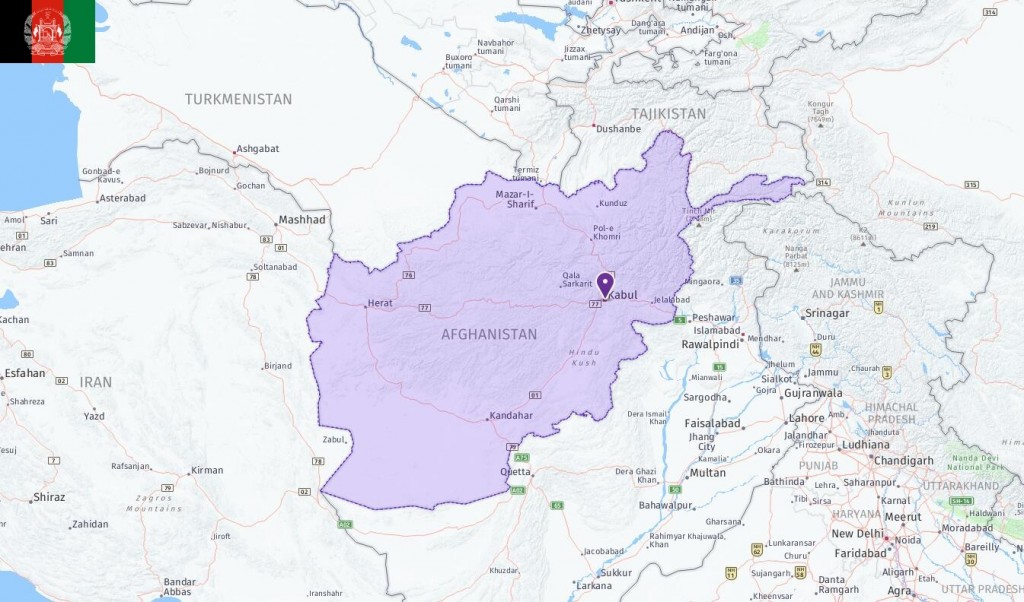AF is the abbreviation for Afghanistan, the 40th largest country in the world. Officially the Islamic Republic of Afghanistan, Afghanistan is a country located in Central Asia (or South Asia), bordering 6 countries: Pakistan, Iran, Turkmenistan, Uzbekistan, Tajikistan, and China. The capital and largest city is Kabul. Other major cities include Kandahar, Herat, Mazar-i-Sharif, Jalalabad, Kunduz, Ghazni, Taloqan, Puli Khumri, and Khost.

Country Profile
- Capital: Kabul
- Language: Dari, Pashto
- Area: 652,230 km2
- Population: 31,575,018
- Currency: Afghani (AFN)
- Time zone: UTC+4:30
- Calling code: 93
- ISO 2-Letter Abbreviation: AF
- UN 3-Letter Abbreviation: AFG
- Internet TLD: .af
- State Government Website: mfa.gov.af
List of Afghanistan Acronyms
The most commonly used abbreviations about Afghanistan are AF which stands for Afghanistan and AFN which means Afghani (Afghanistan currency). In the following table, you can see all acronyms related to Afghanistan, including abbreviations for airport, city, school, port, government, and etc.
Geography
In area, Afghanistan is almost twice as large as Norway, and the border with Pakistan is almost as long as our entire national border. Most of the country consists of rugged mountain terrain, with deep valleys and high mountains. The highest mountain is called Noshaq and is 7492 meters high. The Hindu Kush mountain range, which extends northeast from the border with China and Pakistan and extends south-west deep into Afghanistan. The mountain range separates the northern provinces from the rest of the country. The country has a typical inland climate, with hot summers and cold winters.
Drought, soil erosion and lack of clean drinking water are a major problem for the population, and there is sparse forest. Nevertheless, Afghanistan is not a country suffering from water shortages on its part. In the north of the country there are low lying plains with relatively fertile soil, and in the spring, melt water from Hindu Kush rivers, rivers and lakes. However, most of the water flows out of the country. The old irrigation systems have been destroyed and the cost of repairing them is estimated at US $ 2 billion.
History
Afghanistan has been an important trajectory for trade and travel between East and West ever since ancient times, when the old Silk Road crossed the country. The country has been dominated by Persians, Greeks, Tajiks and Mongols alike. It was not until the 18th century that the country became independent when modern Afghanistan was founded by Ahmad Shah Durrani.
Afghanistan used to control much of today’s Pakistan and Iran, but during the 19th century there was a conflict between Afghanistan and the British that ruled India. In a 1919 peace treaty, Afghanistan had to give up large areas in today’s Pakistan. Throughout the 20th century, lack of economic development led to internal conflicts, and in 1973 the king was deposed in one coup. In 1979, the Soviet Union invaded to support the Communist Party, which had taken power the year before. The occupation faced strong resistance in the population, armed with money and weapons from the United States and China. More than 800,000 Afghans were killed in the conflict, and more than 5 million fled.
When the Soviet Union withdrew in 1989, they left a country in crisis. The result was seven new years of civil war before the Islamist Taliban regime took control. The Taliban was a totalitarian regime where opposites were persecuted and women were refused to work and study. For many Afghans, however, the Taliban represented tranquility after many years of war.
On September 11, 2001, the Afghanistan-based terrorist network attacked al-Qaeda, prompting the US to invade Afghanistan and overthrow the Islamist Taliban regime. In the years that followed, there was a war between a coalition of international forces and the Taliban. The Afghan government and its international supporters have not achieved peace and stability in the country, and the conflict with the Taliban is still ongoing.
Society and politics
Afghanistan is an Islamic republic, organized by the pattern of a federal republic. The Republic is divided into 34 provinces, which in turn are divided into 398 districts. The country is governed by a president and two vice presidents, all of whom are directly elected for a term of five years, they can only be re-elected once. The President is responsible for the country’s foreign policy, defense and civil rights. He is both head of government and leader of the military, and can veto proposals from the National Assembly.
The conflict between the Taliban, the federal government and international forces has gradually weakened the government in recent years. Many in Afghanistan are dissatisfied with the foreign military presence and support the Taliban in their warfare. At the same time, many also support the government. The health services and educational services in the country are deficient and there is a lot of corruption. In addition, the Islamic State (IS) has become a player in the conflict, something the UN fears will lead to increased conflict between Sunni and Siamese Muslims, since IS purposefully attacks Shia Muslims.
Economics and Commerce
Afghanistan’s economy has suffered during the many decades of war and conflict. The country has relatively large natural resources, including in the form of minerals such as coal, copper and iron ore, as well as some oil and natural gas. Natural resources have been scarcely exploited due to the unrest in the country and because of lack of proper roads and transport opportunities. Although it does not appear in the official figures, illegal opium production is a cornerstone of the Afghan economy.
Afghanistan is completely dependent on international aid, and much of the country’s gross domestic product comes from aid and military presence. Due to armed conflict, corruption, high crime and a weak state apparatus, the government in Afghanistan is struggling to rebuild the country, even though there has been economic growth since the Taliban was overthrown.
View this article in other languages:
Deutsch – Français – 繁體中文


